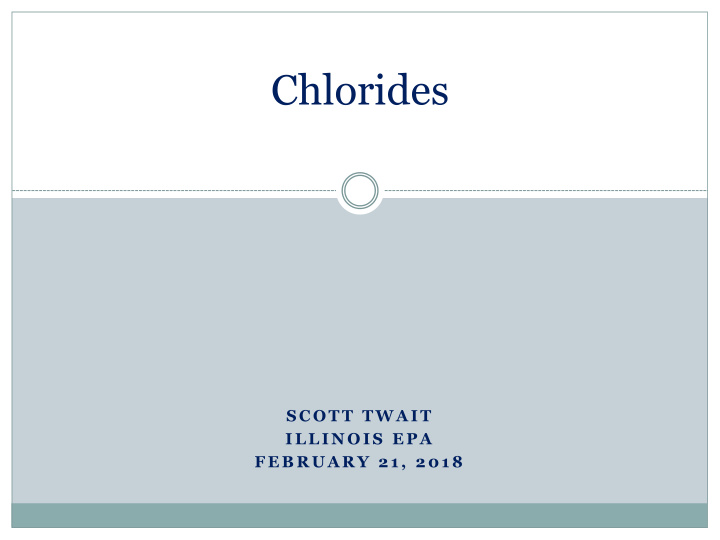



Chlorides S C O T T T W A I T I L L I N O I S E P A F E B R U A R Y 2 1 , 2 0 1 8
Topics Covered 2 Variances/Time Limited Water Quality Standards Chlorides
Variances Illinois had individual variances. A few years ago one of the variances that were approved by the Illinois Pollution Control Board (IPCB) was disapproved by USEPA. The existing state variance requirements were not entirely compatible with USEPA’s variances. In 2015, USEPA published rules on WQS variances. Illinois decided to change variances to make them more compatible with USEPA.
Time-limited Water Quality Standards (TLWQS) Legislation changing Variances (time-limited water quality standards(TLWQS)) passed by the legislature and signed by the Governor The Agency proposed rules to the Illinois Pollution Control Board. (R2018-18) R2018-18 currently on 2 nd notice Changed name to Time-Limited Water Quality Standard
Time-Limited WQS 5 ▪ Time-limited water quality standards will allow: ▪ Individual TLWQS ▪ Multi-discharger TLWQS ▪ Stream Segment TLWQS ▪ Watershed TLWQS ▪ Time-limited water quality standards keep the stay provisions. ▪ Consistent with USEPA variances. ▪ Allows greater than a five-year timeframe.
Chlorides in the CAWS HISTORY - IMPLICATIONS ON PERMIT HOLDERS - TLWQS -
Chicago Area Waterway Rulemaking (R08-9) 7 Before this rulemaking, these waterbodies were considered as Secondary Contact: North Shore Channel – Use A 1. North Branch Chicago River – Use A 2. Chicago River - General Use 3. South Branch Chicago River – Use A 4. South Fork tributary to South Branch Chicago River - Secondary Contact 5. and IAL Chicago Sanitary and Ship Canal (CSSC) – Use B 6. Lower Des Plaines River 7. Calumet River – Use A 8. Lake Calumet – Use A 9. Lake Calumet Connecting Channel - Use A 10. Grand Calumet River - Use A 11. Little Calumet River - Use A 12. Calumet-Sag Channel - Use A 13.
Chloride Standard Adopted by the Board 9 The Board adopted a year round single value of 500 mg/L chloride water quality standard for the Upper Dresden Island Pool, Aquatic Life Use A waters and Aquatic Life Use B waters. 302.407 (g)(2) – effective July 1, 2015 until July 1, 2018 May 1 – November 30 Chloride = 500 mg/L December 1 – April 30 Total Dissolved Solids = 1,500 mg/L 302.407 (g)(3) – effective July 1, 2018 Chloride = 500 mg/L
Chlorides 10 Chlorides stay in the environment. Chlorides don’t get removed through traditional Wastewater Treatment Plants. Chlorides don’t get removed from the streams or groundwater by any natural degradation.
Kelly Report Kelly report looked at sources of chloride in Illinois Natural Sources (rain water and rock-water interactions) Human Waste Livestock Waste Road Deicers Water Conditioning Salts KCL Fertilizers Municipal Landfills Oil and Gas Exploration
Kelly Report According to the Kelly report, an estimated annual average of 471,000 metric tons of road salt were used in Illinois for the years 2002 to 2005, mostly in the Chicago Region. Average annual road salt sales have increase since 2005.
Kelly Report Bulletin B- 74, “The Sources, Distribution, and Trends of Chloride in the Waters of Illinois”, Walton R. Kelly, Samuel B. Panno, Keith Hackley, March 2012, ISWS, page 27.
Reports/Data on Chloride Concentrations in Illinois Streams 14 1. USGS’s article - Urban Stream Contamination Increasing Rapidly Due to Road Salt WI.Water.USGS.gov 2. The Sources, Distribution, and Trends of Chlorides in the Waters of the Illinois Kelly Report 3. MWRDGC’s Data Network 4. Data at I-55 bridge 5. Other data
Chloride percentage above 500 mg/L Jan. 2001 through Dec. 2012 (Dec. – March) North Shore Channel – 8% North Br. Chicago River – 13% South Br. Chicago River – 4.4% S. Fk. S. Br. Chicago River – 4% CSSC - 6% Cal-Sag - 2.6% Little Calumet River – 2.3% Des Plaines River – 6% (2001 data only) Grand Calumet and Calumet Rivers – 0 above 500 mg/L
Implications on Point and Non-Point Sources 16 The Illinois EPA uses an acute criterion of 500 mg/L, but there is no chronic standard. The adoption of a chloride water quality standard for CAWS water bodies will result in listing many of these water bodies as impaired for 303d/305b purpose. Impaired TMDL The impaired status of CAWS water bodies will significantly affect point and non- point sources’ ability to do future projects that would add additional chloride loadings to these water bodies.
Chloride Workgroup 17 IEPA asked MWRD to coordinate a workgroup with a goal of applying for a variance/TLWQS. MWRD has set-up workgroups to generate the variance requirements: Legal Data acquisition Best Management Practices (MS4, Industrial, CSO communities) Water Quality Social and Economic Impact
Watershed TLWQS for Chloride New Chloride Water Quality Standard for Chloride- Chicago-area Waterways System (CAWS) New regulations go into effect July 1, 2018. Chloride = 500 mg/L (matches the rest of Illinois) The Chloride watershed TLWQS will require the dischargers to perform BMPs based on the type of discharger (MS4, municipal discharger, industrial discharger, IDOT/Tollway, etc.) The TLWQS will allow time for the dischargers to implement BMPs to allow the chloride water quality standard to be achieved.
Chlorides-
Chlorides TLWQS 20 Classes POTWs Communities with CSO Outfalls Industrial Sources MS4s IDOT / Tollway Salt Storage Facilities
MWRDGC Contact 21 Brian Perkovich perkovichb@mwrd.org http://chlorides.mwrd.org
North Branch Chicago River Watershed Workgroup 22 North Branch Chicago River upstream of the Confluence of North Shore Channel is not included in the watershed for the CAWS TLWQS. Data may be available on the North Branch Chicago River (MWRD) Keep an eye on the CAWS chloride TLWQS
Questions? 23 Scott Twait 217/558-2012 scott.twait@illinois.gov
Recommend
More recommend